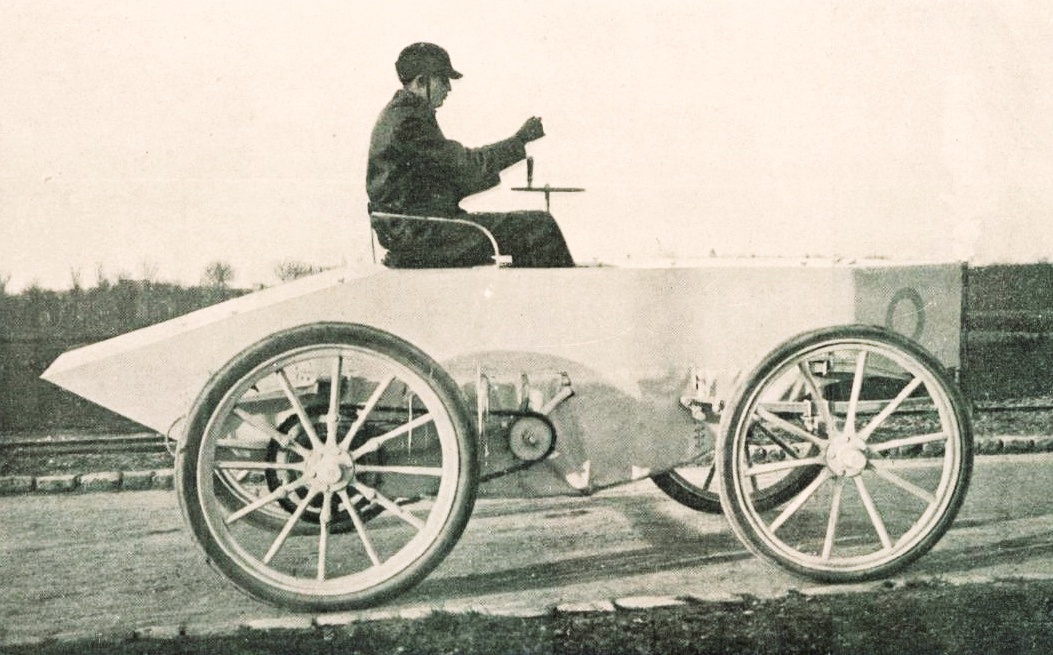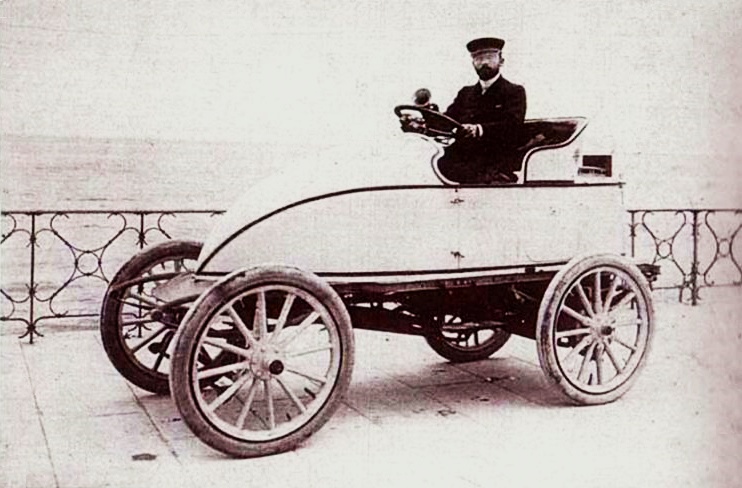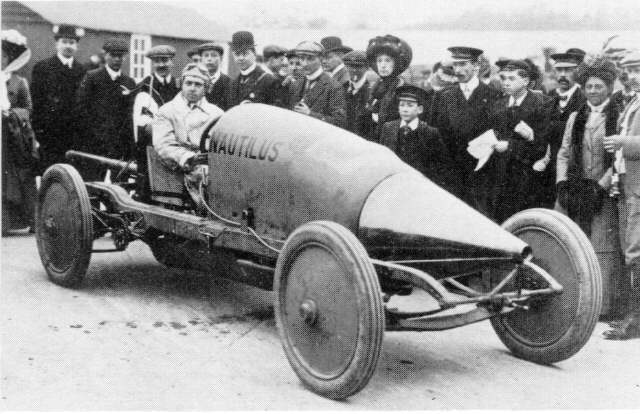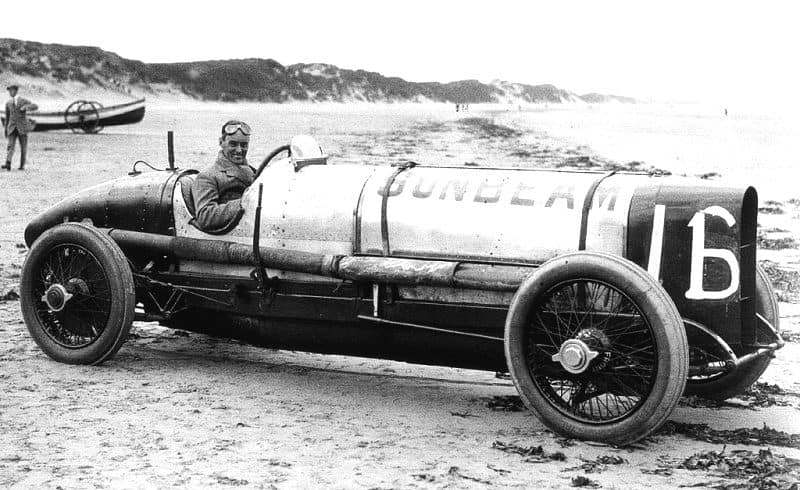It sounds so simple, when speed record breaking is distilled to its essence; cover a set distance in the shortest possible time.
But they omit so much of what lies behind such endeavours that they sell it short. Since Frenchman Count Gaston de Chasseloup-Laubat and Belgian Camille Jenatzy went head-to-head in their battle to become the fastest man on earth in 1898, it has been about so much more than simply building a vehicle with the greatest possible power output, then inserting a driver with instructions to keep his right foot nailed to the floor.
World speed record attempts have never been just a story of cold scientific research, development and execution. Far from it. Up until the Seventies the intuitive mechanical opportunism and attitude of the hot rodder was often as much a part of some of the stories as the complex amalgam and application of engineering skill, but the underlying foundations have always embraced pure human courage, passion and indefatigable endeavour.
Driving a record machine at full speed, on narrow, tree-lined public roads, on the sands of Pendine in North Wales and Daytona in Florida or the vast expanse of the Bonneville Salt Flats in Utah, is one of the loneliest pursuits in the world. Yet, paradoxically, it also requires a supportive team effort born of brains, camaraderie, mutual respect and reliance.
And it isn’t just the driver who requires courage. The late Ken Norris, who with his brother Lew created Donald Campbell’s famed Bluebird CN7 car and K7 boat, once revealed the awful burden that the designer must also carry: “When we first considered doing the boat I knew we had to accept responsibility, and the challenge from the design standpoint. I said that you first had to convince yourself that you are capable because you have this man’s life in your hands. You’ve got to say, ‘Can I do it?’ And that is always a pretty difficult question.”
Within such human and technological elements, together with the underlying and endless battle with an often-disgruntled Mother Nature, lie the true challenge of speed record attempts.

In the beginning, the electric car was the king. His Jeantaud fitted with a vertical chisel-shaped nose to cheat the wind, Chasseloup-Laubat recorded 39.24 mph (63.15 kmh) on December 18 1898, on a straight piece of road near Acheres in France. In January the following year, Jenatzy and his bespoke cylindrical-shaped electric racer, appositely named Le Jamais Contente – The Never Satisfied – beat that with 41.42 mph (66.66 kmh) before Chasseloup-Laubat replied with 43.69 mph (70.31 kmh) later the same day. Ten days later Jenatzy’s response was 49.92 mph (80.34 kmh) before his rival hit back with 57.60 mph (93.724 kmh) in March. Jenatzy, named ‘The Red Devil’ because of his red hair, had the last word, with 65.79 mph (105.904 kmh) in April.
Electricity was soon supplanted by steam, when Leon Serpollet’s Ouef des Paques – Easter Egg – recorded 75.06 mph (120.771 kmh) on the Promenade des Anglais in Nice in April 1902. And steam, in turn, was beaten by the internal combustion engine, when the wealthy American William Vanderbilt Jnr took a Mors racing car to 76.08 mph (122.431 kmh) in August that year and set in train a series of improvements as fellow racers Henri Fournier and Georges Auger (racing as ‘Augieres’) boosted the mark to 76.60 (123.249) and 77.13 mph (124.102 kmh) that November.

Racer Arthur Duray took a vast Gobron-Brillie to 84.73 mph (136.353 kmh) a year later, but it was Louis Rigolly who achieved the big breakthrough with 103.55 mph (166.628 kmh) at Ostend in 1904.
Racing cars continued to increase the record, until World War 1 bequeathed the aircraft engine. Sunbeam boss Louis Coatalen shoehorned a surplus Manitou aero-engine into a racing car; where the Gobron had 13.6 litres of horizontally-opposed four-cylinder engine and 130 bhp, the Sunbeam boasted 350 bhp from its 18.3-litre V12 and rewrote the script.

In 1922, Kenelm Lee Guinness took the car to 133.75 mph (215.25 kmh) – a speed beaten by Rene Thomas’s 10.6-litre V12 Delage with 143.31 mph (230.634 kmh) in 1924 and Ernest Eldridge’s 21.7-litre six-cylinder FIAT ‘Mephistopheles’ with 146.01 mph (234.986 kmh) six days later. In subsequent years Captain Malcolm Campbell would helm the Sunbeam, albeit modified and painted to reflect its new Blue Bird name, to 146.16 and 150.766 mph (235.217 and 242.80 kmh) before Major Henry Segrave intervened with a 4-litre Sunbeam racing car at 152.33 mph (245.149 kmh) in 1926.
That was the racing car’s swansong, however, as the late Twenties ushered in the era of the monster.

Welsh engineering genius John Godfrey Parry Thomas made a silkier purse out of Louis Zbrowksi’s brutal Higham Special and beat the record twice on Pendine Sands in 1926, with a big jump to 169.30 mph (272.458 kmh) and then 171.01 mph (275.229 kmh) before Campbell returned with a bespoke Blue Bird in February 1927 to record 174.883 mph (281.447 kmh). Thomas became speed record breaking’s first fatality while seeking to beat that a month later.
That same month, Segrave became the first man to exceed 200 mph (321 kmh) with 203.79 mph (327.981 kmh).
His big red Sunbeam broke much new ground: it was the first land speed car with a full-width streamlined body, and mounted one 22.5-litre V12 435 bhp Matabele engine ahead of the driver and another behind, the resultant power conveniently rounded up to 1000 hp for publicity.
Segrave also initiated European usage of Daytona Beach, which became the new mecca for speed seekers. In 1928 they included Campbell, whose modified Blue Bird reclaimed the record at 206.956 mph (333.062 kmh). Two American ventures met with varying success, however. Flame-haired giant Ray Keech wrestled the crude Triplex Special – a behemoth powered by three 26.9-litre Liberty V12s – to 207.55 mph (334.022 kmh) to beat Campbell; rival Frank Lockhart crashed his beautiful and scientific 3-litre V16 400 bhp Black Hawk Stutz at 200 mph (321 kmh) yet survived, only to lose his life in a second accident two months later. And after Segrave had smashed America’s record with 231.446 mph (372.340 kmh) in March 1929 with his beautiful Golden Arrow, Keech’s successor Lee Bible died when he lost control of the Triplex.
Thereafter Campbell owned the record, boosting it on another five occasions in increasingly modified Blue Birds, until he broke another barrier with 301.129 mph (484.818 kmh) in September 1935.
In turn he was supplanted by fellow British racing drivers George Eyston and John Cobb, who waged a gentlemanly battle on the Bonneville Salts Flats to which a desperate Campbell had decamped gratefully for his final attempt after wheelspin at Daytona had robbed him of crucial speed. Eyston’s self-designed Thunderbolt was powered by two 36.5-litre 2350 bhp Rolls-Royce R engines, had eight wheels (the front four doing the steering) and weighed seven tonnes; Cobb’s Reid Railton-designed Railton Special ingeniously mounted two old 1250 bhp Napier Lion engines in a lightweight s-shaped chassis clothed with a beautifully streamlined bodyshell, and was the first record car to use four-wheel drive. Each broke the record three times; Eyston’s best was 357.500 mph (575.217 kmh), Cobb’s a dramatic 394.200 mph (634.267 mph), with a fastest one-way run of 403 mph (648 kmh).
That mark would last for 17 years, and in 1960 resulted in the Great Confrontation at Bonneville when technical ingenuity knew no limit. Art Arfons and Athol Graham had ‘conventional’ aircraft piston-engined contenders; hot rod genius Mickey Thompson a brilliant pukka automobile with four Pontiac engines and four-wheel drive; Donald Campbell’s Bluebird CN7 introduced the turbine engine, also driving all of its wheels; and Dr Nathan Ostich’s Flying Caduceus was the first LSR car powered by pure thrust, via a General Electric J47 turbojet which did away with the need for a transmission.
All of them failed. Graham and Campbell crashed, the American fatally; Arfons’ Anteater was too slow, as was Ostich’s jetcar; Thompson hit 406.60 mph (654.341 kmh) on Challenger’s first run but blew an engine on his return. Four years later the recovered Campbell averaged 403.10 mph (648.728 kmh) on Australia’s Lake Eyre, but by then that counted only as a wheeldriven record and would be beaten a year later by Bob Summers’ Goldenrod at 409.277 mph (658.636 kmh); the jets had taken over.
Craig Breedlove’s 407.45 mph (655.709 kmh) run in 1963 was not ratified by the FIA (though the FIM accepted the tricycle Spirit of America jetcar’s mark as a motorcycle and sidecar record!), but after Tom Green had briefly set the record in Walt Arfons’s Wingfoot Express at 413.20 mph (664.95 kmh) in October 1964, the record became a perilous war of Russian Roulette between Breedlove and Walt’s estranged brother Art. Arfons won 1964 with 536.71 mph (863.710 kmh) as Breedlove crashed into a brine lake; in 1965 the latter returned with a new car, Spirit of America – Sonic 1, ending the year on top with 600.601 mph (966.528 kmh). In 1966 it was Arfons’ turn to walk away from an accident – at 600 mph (965 kmh)…
There things stalled until 1970, when Reaction Dynamics’ The Blue Flame really was rocket science. Powered by a bespoke rocket motor designed to run on hydrogen peroxide and liquefied natural gas, the four-wheeled pencil encountered myriad teething problems before colourful hippy Gary Gabelich broke through with 622.407 mph (1001.639 kmh), beating 1000 kmh for the first time. Later that evening, the winter snow came to Bonneville. Literally and figuratively, the hot rod era had been superseded by the age of cold science.
In life, what goes around tends to come around. So it has been with both electricity and steam, which, while no longer strong enough to create outright record holders, have had fresh moments in the spotlight since the earliest attempts.
In tune with the world’s burgeoning interest in electric cars, students at the Ohio State University’s Centre for Automotive Performance have allied with Venturi to produce a series of Buckeye Bullet electric battery/hydrogen fuel cell-powered land speed cars, the fastest of which in Roger Schroer’s hands achieved 307.905 mph (495.526 kmh) at Bonneville in 2010. Their ultimate aim is 400 mph (643 kmh).
Steam hasn’t been left behind, either. In 2009 Charles Burnett III achieved 139.843 mph (225.049 kmh) through a mile, and Don Wales 148.166 mph (238.443 kmh) through a kilometre, in the British Steam Car.
The diesel-fuelled internal combustion engine, too, has made headlines; in August 2006 supersonic record breaker Andy Green earned his salt spurs with 350.092 mph (563.403 kmh) in JCB’s twin-diesel-powered Dieselmax at Bonneville.
David Tremayne is a motorsports journalist with an abiding interest in the Land Speed Record. To read about how the story has continued, click here to read how Ron Ayers, chief aerodynamicist of the team that broke the sound barrier on land, took the record into the days of digital technology. To read our comprehensive library of stories and features on the current LSR attempt Bloodhound SSc, click here.




Red Bull makes hydrogen fuel cell play with AVL
Formula 1 is an anachronistic anomaly where its only cutting edge is in engine development. The rules prohibit any real innovation and there would be...